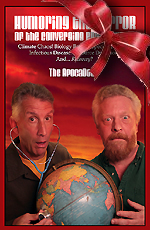SEARCH
A great gift
for crisis deniers!

Humoring the Horror of the
Converging Emergencies
94 color pages
$24.99 now $15!
Or read FREE online!

Twitter

Ping this story
in social media:
del.icio.us
Digg
Newsvine
NowPublic
Reddit
Facebook
StumbleUpon
|
 |
|
 |
|
 |
|
 |
|
Huge 2007 Arctic tundra fire points to new climate feedback http://apocadocs.com/s.pl?1312122825
An exceptional wildfire in northern Alaska in 2007 put as much carbon into the air as the entire Arctic tundra absorbs in a year, scientists say.
The Anaktuvuk River fire burned across more than 1,000 sq km (400 sq miles), doubling the extent of Alaskan tundra visited by fire since 1950.
With the Arctic warming fast, the team suggests in the journal Nature that fires could become more common.
If that happens, it could create a new climate feedback, they say....
But 2007 saw unusually warm and dry conditions across much of the Arctic - resulting, among other things, in spectacularly fast melting of Arctic sea ice.
This created conditions more conducive to fire, and when lightning struck the tundra in July, the Anaktuvuk River fire ignited.
"Most tundra fires have been very small - this was an order of magnitude larger than the historical size," said Michelle Mack from the University of Florida in Gainesville, who led the research team on the Nature paper and is currently conducting further field studies in Alaska.
"In 2007, we had a hot, dry summer, there was no rain for a long period of time.
"So the tundra must have been highly flammable, with just the right conditions for fire to spread until the snow in October finally stopped it."...
Another impact of the fire that has yet to be fully assessed is that the blackened soil absorbs more solar energy than normally vegetated tundra.
This abets melting of the permafrost layer below.
"Once permafrost melts beyond a certain depth on a slope, then all of the organic layer slides down the slope like a landslide," Dr Mack told BBC News.
"This whole issue of melting can lead to other huge changes in drainage, in areas of wetlands - releasing carbon that's been frozen since the Pleistocene [Epoch, which ended more than 10,000 years ago]."
|
|
 |
|
 |
|
 |
[Read more stories about:
arctic meltdown, holyshit, feedback loop, permafrost meltdown]
|
 |
|
New!:
| |
|
No reader quips yet -- be the first! | |
|
Got a PaniQuip?
|
|
|
We reserve the
right to reuse, remove, or refuse any entry.
| |
|
 |
'Doc Michael says:
|
 |
 |
 |
New concepts learned today: 1) Tundra fires. 2) Permafrost landslides. 3) omg
|
|
|
|
 |
Want to explore more?
Try the PaniCloud!
|










